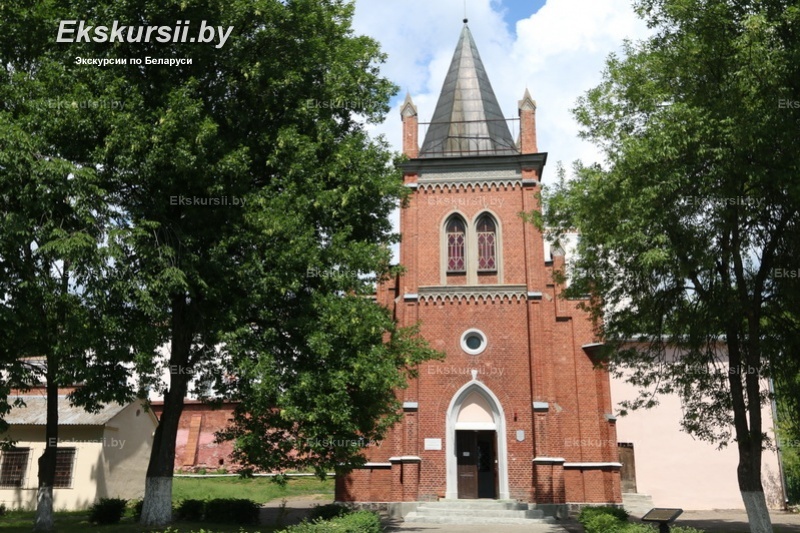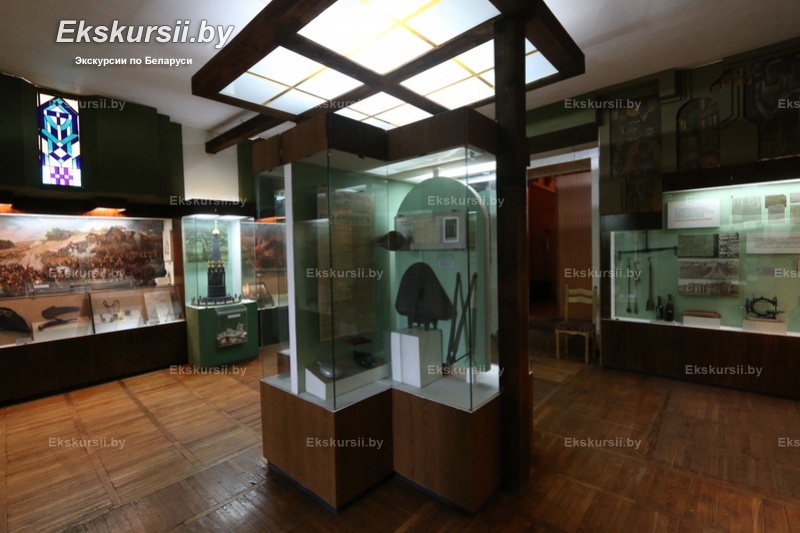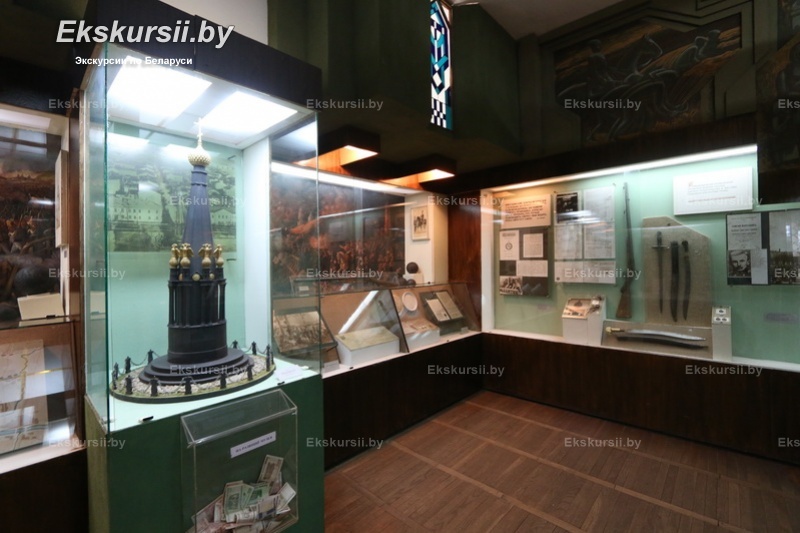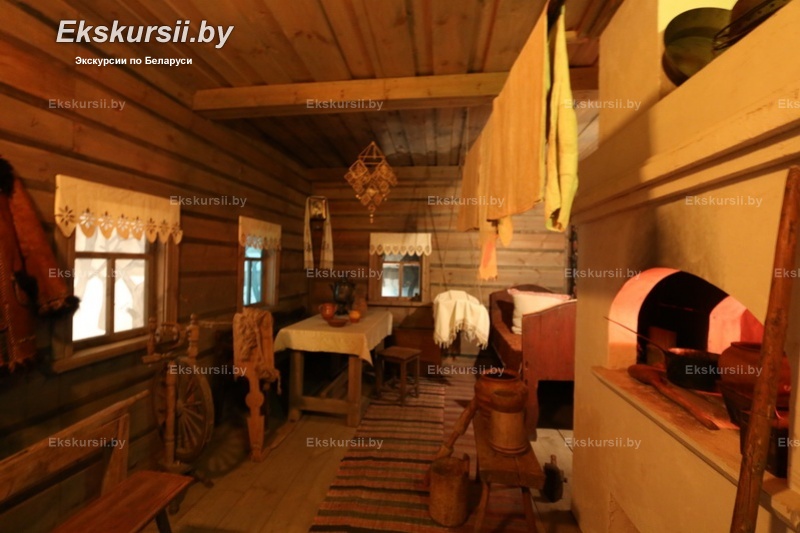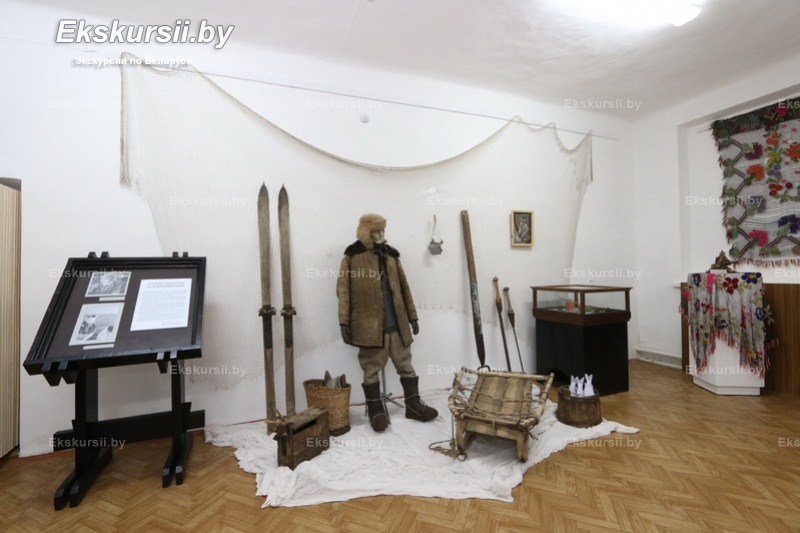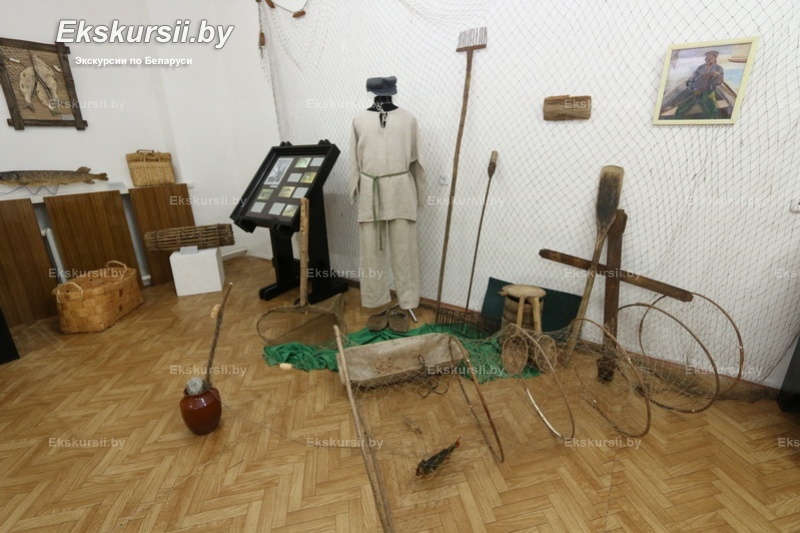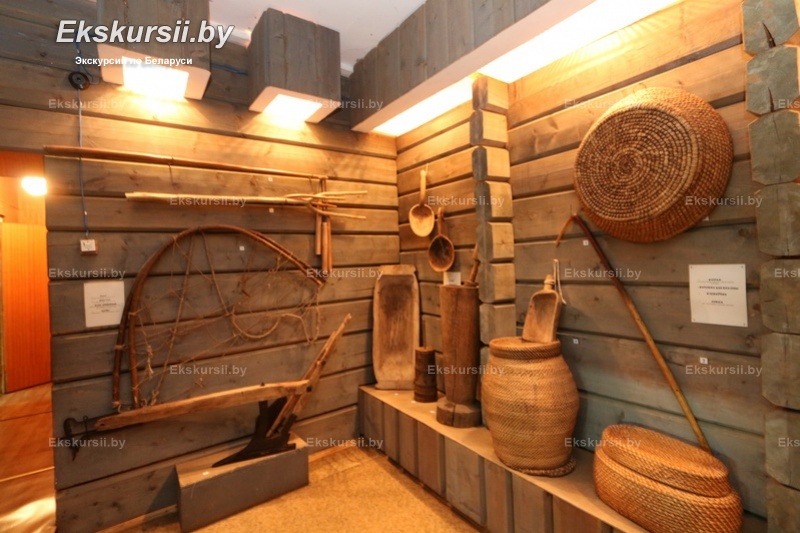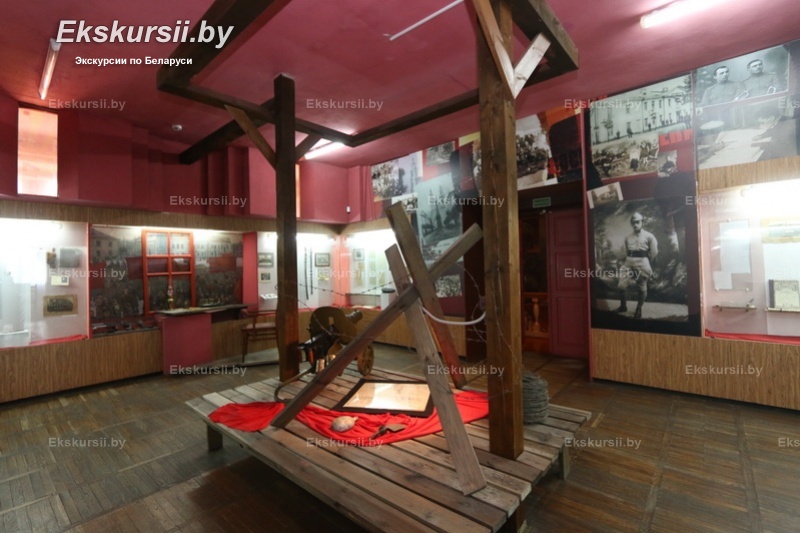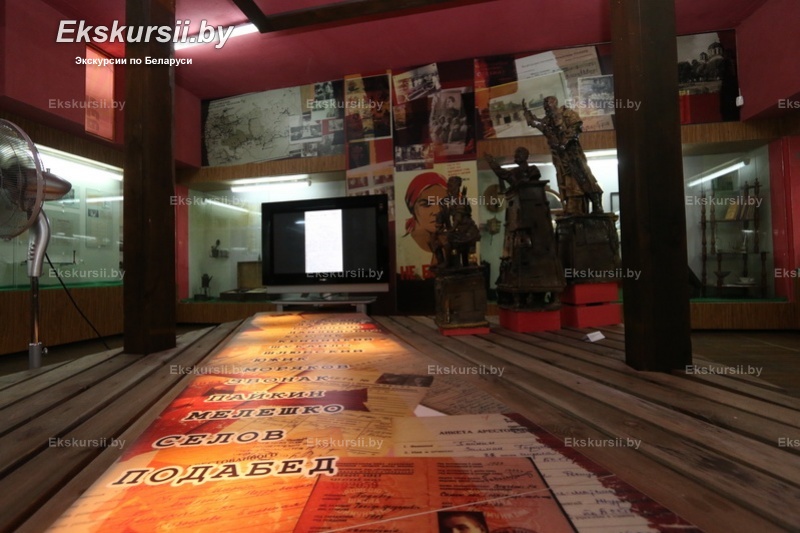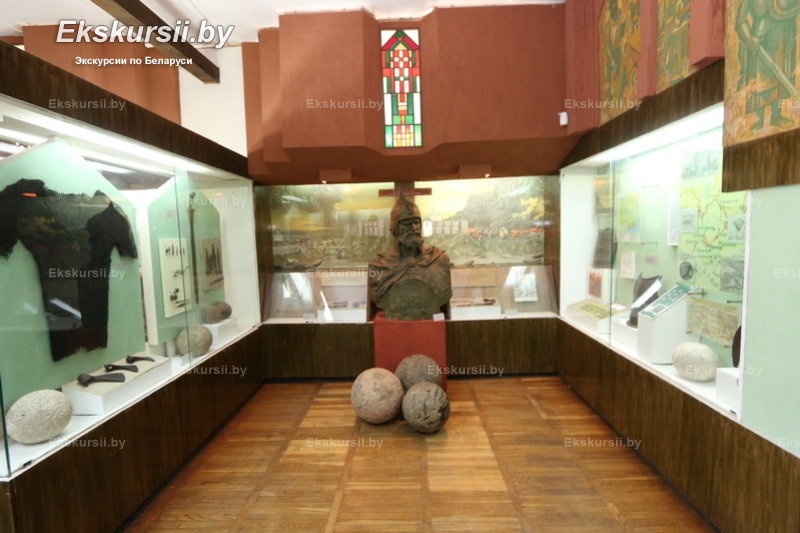form for casting the medallion IA Shilov
Exhibits related to the War of 1812 - a medallion with the image of Alexander I, IA made Shilov (1788-1827). In 1816, a master of sketch produced molds for porcelain medallion with the image of the Greek warrior with a sword in his right hand, personified by Alexander I. Molds and custom-shaped locket (master B. Ghaleb) can be seen today in one of the halls of the museum.
French gun "AN XIII" - on display in the hall, this classic events of the war in 1812 It was the most perfect and most common French cavalry pistol in the era of the Napoleonic wars. Made it to the manufactories of Charleville, St. Etienne, Maubeuge, Versailles and Esen. It was released about 300,000 units. This weapon was used by only the officers, trumpeters and some non-commissioned officers.
Puleleyka VIII century. - Found in 2005 during excavations under the direction of D. Duka at the former Grand quarter. The dominant technology for the manufacture of lead shot was cast as the main tool for this is the puleleyki (form). Puleleyka consists of two halves with a handle connected to each other (like scissors) bolt and nut. Both halves, brought together, constitute cu. Contiguous workers (internal) surface halves have bullet nest hemispherical shape with the upper channel or the muzzle of.
dolman officer
(short coat) is the main element of any army uniforms. Vaukavysk military-historical museum of local lore museum named after PI Bagration was handed dolman officer Hussars French army uniforms of white color in the form of short swing cloth jacket to the waist with a standing collar. The front of the uniform cross-stitched 13 rows of double Silver Shnurova laid on Conti in curls, with three rows of 13 buttons smooth.
Shako officer - an integral part of the uniform of a soldier in the Russian army hih - a military headdress. The exposition of the museum of local lore is quiver officer of the Life Guards Hussar Regiment, 1st half of the XIX century. The headpiece is expanding to the top of the truncated cone red, height 25.5 cm on the front of the quiver mark in the video the two-headed eagle with a torch in his right paw and a laurel wreath on the left. It is often kept the money, beds, comb, brush for Usov, Fabre, wax, lipstick, needle and thread. The officer was transferred to the museum spire Vaukavysk military-historical museum named after PI Bagration.
interesting documents from the archives of PG Ilmer
in 1996 was discovered archive Pinkhus Rumanova Ilmer, owner Steamboil tannery. The documents of the early twentieth century are mainly business-like. This is a letter with orders and supply of goods, cards with messages, business cards, business partners, price lists people. Business correspondence provides insight into the wide geography of procurement, supply and business ties factory owner in Riga, Warsaw, Moscow, Hamburg, Moscow, Rostov, Uralsk and other cities.
кyselivka
subject of an interior of a peasant house of the late XIX - early XX centuries, unusual stick, similar to poker. It was used for the preparation of an ancient Belarusian dishes - oatmeal. Kyselivka length - 143 cm, it was done in the 1940s. Gluboksky in the area.
pendants charms
archaeological finds X-XIII centuries. burial in female graves. Attracts the attention of visitors and suspension-horse.
photo portrait of I.K. Tomkovida (1888-1972)
graphic artist, a grandson of IF Hrutskogo. He worked as a cartoonist under the pen name "Icarus", illustrated children's books. The museum is a photograph of the first quarter of the twentieth century, in which the young Ivan Tomkovid eyes of an experienced artist peers at a blank sheet of paper and pencil sketches of the future drawing. This photo in the museum-reserve came in 2001 from a resident of Kiev Padun Lukianova L.N.
silver thaler-efimok
a large silver coin, which was used by merchants to cash payments - Thaler. On the Russian lands Thaler called "efimok" - distorted name "ioahimstaler", derived from the city Ioahimova where the coin was first minted in 1518 Found "efimok" in 1979 during archaeological excavations in the Upper Castle led to the . Bulkin. Efimki remained in circulation prior to the Russian 1659
medal ”In memory of the 100th anniversary of the War of 1812”
she was transferred Kobrin military history museum named after Suvorov in 1954. Established in 1912 - the year of the 100th anniversary of World War II. The award was made of a light bronze. On its front side - bust of Alexander I, emperor with no attributes. On the flip side - a lengthy inscription in seven lines of: "1812 this glorious year minul, but not what he did unto proydut nem feats 1912". It was produced about 442 thousand commemorative medals. Awarded this medal is not only military but also civil servants, clergy person, who took an official "... participation in parades and at Borodino near Moscow," officials of the Imperial Chancellery.
textbook ”GRAMMATICA LINGVAE LATINAE”
grammar of the Latin language in three parts in 1794. Its author - Emmanuel Alvar (EMMANUELIS ALVARI) (1526-1585) - Portuguese Jesuit. First published in Lisbon in 1572, his grammar was in the XVI-XVIII centuries. very popular in Europe. Education on it continued until the middle of the XIX century. "GRAMMATICA" was reprinted only in Polotsk in 1790, 1794, 1815 and 1819. The book includes treatises on the Polish spelling and pronunciation of Polish words. The textbook is interesting for its marginalia. Numerous translations of inscriptions, obscure Latin phrases in Polish evidence of active use it for its intended purpose. The owner of the book has left in its pages and your name: Stanislav Gordeev.
Tutorial "GRAMMATYKA LACINSKA PIJARSKA" - in 1741 Stanislav Canary has prepared a new Latin grammar ("GRAMMATYKA LACINSKA PIJARSKA"). The book has been introduced in all the domestic public-relations school, reprinted several times. The exposition of the museum of local lore stored "GRAMMATYKA LACINSKA PIJARSKA" in 1824, which was published in Berdichev in the printing of the Barefoot Carmelites. Tutorial outlining the different three-quarters of the theoretical material in Polish. Training material filed in the form of questions and answers. Grammar is divided into 4 parts: for spelling, part of speech, of the syntax of prasodii, placed at the end of the Latin-Polish dictionary.
Manuscript "Lustrator Polocki z Dobr Ex Iezuickih, ad Archivum JO Xcia; Jmci. Radziwilla, Mar. Gener. Konf.: W: X: L CD" - Contains information about the 9 largest farm Polotsk Jesuit XVIII century and is a valuable source for the history not only of Polotsk, but the modern village Ekiman, Casimir, Mosar. Unfortunately, the manuscript is not preserved in full: Parts A and B are absent. Extant Part C and D - the final sections of lustration - represent a large book of 36 pages of stamped paper handmade, in a cardboard cover with remnants of leather jewelry.
Topographic plan «Stadtplan von Polozk» (New!) - One of the most interesting exhibits is the exposition dedicated to the events of the First World War in Polotsk. On the plan, dated June 1918, reflected the river, streets, buildings. All in all it marked 34 streets and 10 alleys. All names are written in Latin letters. Compiled plan written down the names of most of the streets as they sound in Russian: Wokszalnaja-Str., Nizchne-Pokrowskaja-Str. etc. Street names Alexander, Vitebsk and Riga were ending-er (Alexander-Str., Witebsker-Str., Rigaer-Str.), A few street names were changed Nevel and Lepel (Newel-Str., i Lepel-Str.). German were translated for some reason, the street name of the Monastery (Kloster-Str.) and lane Blunt (Stumpfe-Gasse). The plan was submitted to the funds NPIKMZ in 1973, AK Gotovskaja, daughter Karp Fedotovich Gotovsky. In the museum, except the plan can be seen today, and other items related to the KF Gotovskaja: evidence of the military district commissioner, issued Gotovskaja February 26, 1919, letter, "Hero of the Red Army," entrusted to him February 23, 1923 in connection with the celebration of the 5th anniversary of the Red Army, his personal watch holster tablet.
polotsk chess
chess pieces XII-XVII centuries. On the territory of modern Belarus chess was especially popular in the twelfth and fourteenth centuries. In our country there is more than 70 chess pieces, most of them - in Polotsk. In the Polotsk were found 10 figures: kings, queen, bishop, pawn. The earliest - the king made of wood in the form of Christmas trees, found in 1988 at the former Grand tenements during excavations under the direction of S. Tarasova. Her counterparts in the territory of our republic has yet been found. Belarus is the only figure of the late King XVI - early XVII century., Turned from the horns, with complex patterns and signs of inlays, perhaps gold is on display museum. It was discovered during excavations at the former Grand tenements under the guidance of S. Tarasova in 1987
Seal with two coats of arms - Local History Museum in the exhibition can be seen today some stamps. The most interesting and unique is printed with images of "Abduction" and "Stag" period XVI - early XVII century. Made of stone, sandstone, it has the shape of an irregular quadrangle. On both sides there are her highly artistic embossed heraldic, in the technique of carving. On adnoy party figure seen an armed man with a sword in one hand and a shield in the other. This - "Pursuit" - the national emblem of the Grand Duchy of Lithuania, composed of Polotsk was part of a 1307 on the other hand - the outlines of a running deer. "Deer" - the emblem of the Vitebsk province from 1506 until the entry of Vitebsk in the Russian Empire in 1772. Printing was passed in 1987, S. Tarasov, head of archaeological excavations in Polotsk on the Great tenements.
Unique mold of horns - used for casting jewelry, probably beads. The form has been found during archaeological excavations under the direction of archaeologist S. Tarasova in 1987-1988.
